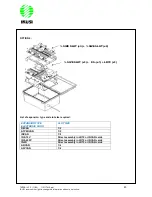
TM70Bi V3.2 (11/02)
1121174 L0.pdf
66
IKUSI reserves the right to change this information without prior notice.
The ramp speed is defined for each semiaxis by a parameter that can take a value between 0 and 15, by default
0. Each of these values corresponds to a ramp time from minimum to maximum value given by the following
table:
0
without ramp
4
0,4 s
8
1,0 s
12
2,0 s
1
0,1 s
5
0,5 s
9
1,2 s
13
2,5 s
2
0,2 s
6
0,6 s
10
1,5 s
14
3,5 s
3
0,3 s
7
0,8 s
11
1,7 s
15
5,0 s
Each output is a PWM signal with current feedback in which is possible the control and compensation of the
switching frequency and pulse width. It also implements a superimposed "dither" signal on the output, with
variable frequency and amplitude, to soften the response of certain hydraulic valves. The "dither" is available
only when the switching frequency of the PWM output is 5 kHz:
PWM Frequency range: 33,35,40,45 ... 1275 and 5000 Hz
Dither Frequency range: 33 ... 255 Hz
Dither Amplitude range: 0 ... 50%
Through Tele-Alignment can set the maximum and minimum values, the polarity inversion, acceleration or
deceleration ramp and curve type of the analogue output. To change to Tele-Alignment mode is necessary to
introduce a bridge in the jumper P6 (see Jumpers configuration).
Only available for TM70 consol box from
3.1 software version or higher.
Other features of the PWM current outputs:
Power supply range of the expansion 8-30V, and of the outputs 5-35V.
Each output channel has 2 outputs only one of which will be connected, according to the sign of the
input. 2 PWM outputs are identical and independent.
The output resolution is 128 steps by semiaxis (256 max – 8 bit), corresponding to step 0 a null output
and step 127 to obtained from the permanent exit from the positive supply.
Max current = 5A (each output).
Outputs protected against short-circuit.
18.2- CONNECTIONS & JUMPERS CONFIGURATION
CONNECTIONS WITH THE LR72
The expansion connects to the LR72 electronic board through two connectors, one of 2 pin for power supply (VI
+ and GND) and the other of 5 pin for the CAN bus with the following signals:
Power connector
Pin number
Function
GND
Ground
+VI
DC between 8 y 30V
CAN bus connector
Name
Function
VCAN
Power supply
CANH
CANH pin of the CAN bus
GNDCAN
Ground (Shielding)
CANL
CANL pin of the CAN bus
GNDCAN
Ground
















































